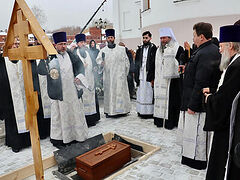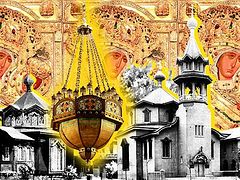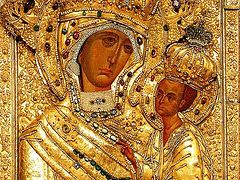 The Tikhvin icon of the Mother of God, according to tradition, is one of the icons painted by the holy Apostle and Evangelist Luke. In the fifth century, the icon was brought from Jerusalem to Constantinople, where the Blachernae Church had been built for it.
The Tikhvin icon of the Mother of God, according to tradition, is one of the icons painted by the holy Apostle and Evangelist Luke. In the fifth century, the icon was brought from Jerusalem to Constantinople, where the Blachernae Church had been built for it.
In 1383, seventy years before Constantinople was seized by the Turks, the icon disappeared from the church and appeared in a radiant light over the waters of Lake Ladoga in northern Russia. Miraculously borne from place to place, it stopped and remained near the town of Tikhvin. On the place where the icon appeared a wooden church was built, dedicated to the Mother of God.
Through the efforts of Grand Prince Vasily Ivanovich (1505–1533), a stone church was erected to replace the wooden one. In 1560, at the orders of Tsar Ivan the Terrible, a men’s monastery was built around the church and encompassed by a stone wall.
In 1613–1614, the Swedish army seized Novgorod and made a number of attempts to destroy the monastery, but the holy habitation was saved through the intercessions of the Mother of God.
Once when the Swedes were advancing on the monastery, the brothers decided to flee and take the miraculous icon with them, but they could not move it from its place. This miracle stopped the fainthearted from carrying out their intention, and they remained in the monastery, hoping in the protection of the Mother of God. Those guarding the monastery were few, but they were able to defend it against enemy forces many times their number. The attacking Swedes were frightened by the appearance of what seemed to them either an enormous army of Russians coming from Moscow, or some army of heavenly hosts, and they fled in retreat.
After this miraculous victory over the Swedes, the Tsar sent an envoy to the monastery. A copy was made of the miracle-working icon, which the envoy took to the village of Stolbovo, fifty miles from Tikhvin, where on February 10, 1617 a peace treaty was signed with the Swedes. The main guarantee of peace from the Russian side was the copy of the miracle-working icon.
Later this copy was brought to Moscow and placed in the Dormition Cathedral in the Kremlin; and later at the request of Novgorodians who participated in the war with the Swedes, it was sent to Novgorod and placed in the St. Sophia Cathedral.
The all-Russia celebration in honor of the Tikhvin icon of the Mother of God, glorified by innumerable miracles, was established by the Church in commemoration of its miraculous appearance and overcoming of enemies through the intercession of the Mother of God.




